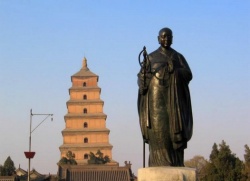Xuanzang's 7th Century Account of Nepal
Xuanzang's 7th Century Account of Nepal
By Indrajala (Jeffrey Kotyk)
Earlier this year I had the good fortune to be able to visit Nepal for the first time. My journey into Nepal started with crossing the Indian-Nepalese border and proceeding to Lumbinī, the birthplace of the Buddha. From there I took a twelve-hour bus ride to Kathmandu. I spent a week or so before leaving. Overall I enjoyed my stay and found the Nepalese people friendly and welcoming.
Today I came across the following passage written by the famous Buddhist pilgrim and author Xuanzang 玄奘 (602 – 664) where he describes Nepal with both praise and reproach.
- 《大唐西域記》卷7:「尼波羅國,周四千餘里,在雪山中。國大都城周二十餘里。山川連屬,宜穀稼,多花菓,出赤銅、犛牛、命命鳥。貨用赤銅錢。氣序寒烈,風俗險詖,人性剛獷,信義輕薄。無學藝,有工巧。形貌醜弊,邪正兼信。伽藍、天祠接堵連隅。僧徒二千餘人,大小二乘,兼功綜習。外道異學,其數不詳。 王,剎帝利栗呫婆種也。志學清高,純信佛法。近代有王,號鴦輸伐摩(唐言光胄)。碩學聰叡,自製《聲明論》,重學敬德,遐邇著聞。 都城東南有小水池,以人火投之,水即焰起,更投餘物,亦變為火。」(CBETA, T51, no. 2087, p. 910, b14-24)
- Nepāl has a circumference of over four-thousand li and is located in snowy mountains. The country's capital city has a circumference of over twenty li. Mountains and rivers are continuous and are good for grains and many fruits. It produces red copper, yaks and jīvajīvaka birds. As a currency they use red copper coins. The weather is cold and frigid. The local customs are rugged and base. The temperament of the people is tough and boorish. Their trustworthiness is lacking. They are unlearned, but possess exquisite skills. Their appearance is ugly and shabby. They believe in both the wicked and good. Buddhist and Brahminical temples are back to back. There are over two-thousand Buddhist monks. Both the Mahāyāna and Hīnayāna are practised together. I am unsure about the number of externalists.
- The king is a kṣatriya and belongs to the Licchavi. He is learned, pure and sincere in his faith in the Buddhadharma. In recent times there was a king named Aṃśuvarmā who was erudite and ingenious. He himself composed a treatise entitled the Śabdavidyā-śāstra, [which is a treatise on words and their meanings]. He valued learning and respected virtue. His reputation spread far and wide.
- South-east of the capital there is a small pond. When people throw fire on it the water erupts into flames. It also changes to fire when other items are thrown into it.
Xuanzang was quick to point out what he considered general ill behaviours of the peoples in the lands he visited. He was a rather harsh critic of the many cultures he visited. On the other hand, when he was impressed he made his positive sentiments quite clear.
Naturally things would have changed between the seventh century and now. However, to be sure, you can still see Buddhist and Hindu temples close to each other. As it was explained to me in Nepal the common people do not strongly distinguish between Hindusm and Buddhism. Nepal also raises plenty of yaks from which milk can be procured.
The jīvajīvaka bird is apparently a two-headed bird said to reside on snowy mountains. Who knows if Xuanzang actually saw such a bird. He recorded a lot of hearsay and local legends in his journal.
If you're interested in Xuanzang's journey, please check out this extensive map on Google Maps detailing the places he visited during his long trip:
